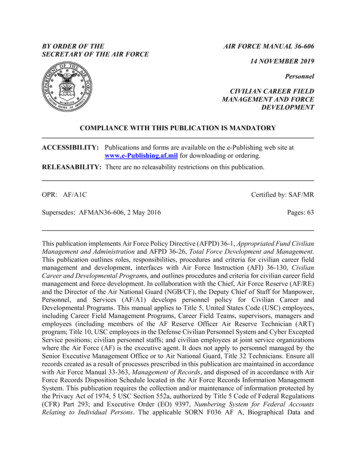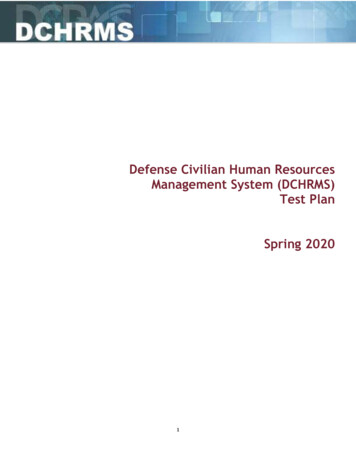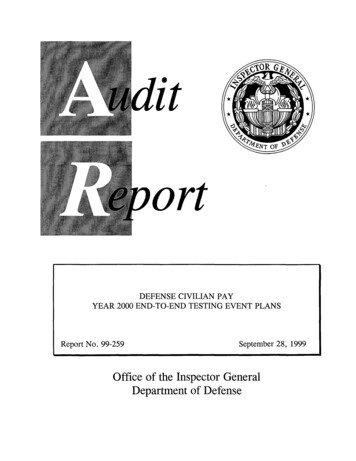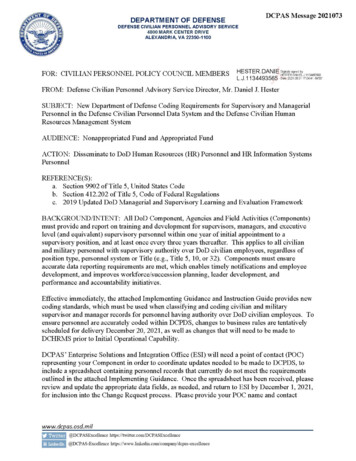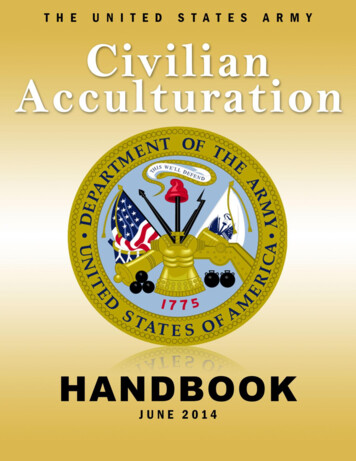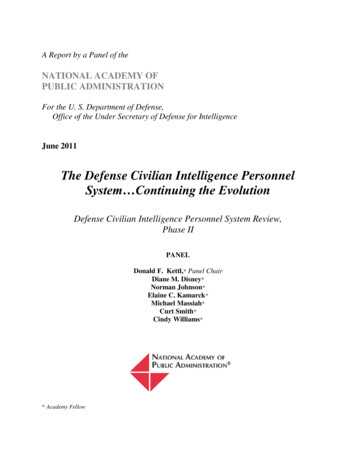
Transcription
A Report by a Panel of theNATIONAL ACADEMY OFPUBLIC ADMINISTRATIONFor the U. S. Department of Defense,Office of the Under Secretary of Defense for IntelligenceJune 2011The Defense Civilian Intelligence PersonnelSystem Continuing the EvolutionDefense Civilian Intelligence Personnel System Review,Phase IIPANELDonald F. Kettl,* Panel ChairDiane M. Disney*Norman Johnson*Elaine C. Kamarck*Michael Massiah*Curt Smith*Cindy Williams** Academy Fellow
U.S. Department of Defense Final ReportInternal Use OnlyOFFICERS OF THE ACADEMYKenneth S. Apfel, ChairDiane M. Disney, Vice ChairDavid F. Garrison, SecretaryRobert J. Shea, TreasurerKristine M. Marcy, PresidentPANELDonald F. Kettl,* Panel ChairDiane M. Disney*Norman Johnson*Elaine C. Kamarck*Michael Massiah*Curt Smith*Cindy Williams*PROJECT STAFFDarlene F. Haywood, Project DirectorLeslie Overmyer-Day, Senior AdvisorTim Dirks, Senior AdvisorDaniel Honker, AnalystShanette Yao, Research AssociateThe views expressed in this report are those of the Panel. They do not necessarily reflect theviews of the Academy as an institution.National Academy of Public Administration900 7th Street, N.W.Suite 600Washington, DC 20001-3888www.napawash.orgPublished June 2011Academy Project Number: 2158-002* Academy Fellowii
U.S. Department of Defense Final ReportInternal Use OnlyFOREWORDIn my nearly 50 years in intelligence, never have I seen a more remarkableexample of focused integration, seamless collaboration, and sheer professionalmagnificence as was demonstrated by the Intelligence Community in the ultimatedemise of Osama bin Laden. The careful, diligent work of CIA, NGA, and NSAwas simply incredible.—General James Clapper, Jr.,Director of NationalIntelligenceMay 2, 2011Mayour2, 2011When the terrorist attacks took place on September 11, 2001,nation experienced one of thedarkest days in its history. Since then, much has been said and written about why these eventsoccurred and what might have been done to prevent them. While questions remain, there is onecertainty that is shared by all who have thoughtfully examined this issue—the United StatesIntelligence Community (IC) could have worked together more effectively to share informationin a way that could have potentially thwarted the attacks.Almost ten years after the terrible events of September 11, we witnessed another remarkableoccurrence that demonstrated the extraordinary success that can result from effective collection,sharing, and fusion of intelligence information. The operation that resulted in the killing ofOsama bin Laden on May 1, 2011 did not happen as a result of any one specific change in theway the IC operates. Rather, it was a result of prolonged efforts to transform the IC into a moreunified organization capable of meeting the many diverse threats of the 21 st century. Asevidenced by this recent success, the 16 agencies of the IC are becoming a more cohesive andintegrated community that is now engaging in more robust information sharing and coordinatedaction.On a smaller scale, the Department of Defense (DoD) has worked to integrate the DefenseIntelligence Components into a more unified Defense Intelligence Enterprise. Of no smallsignificance are the changes DoD is making in the way it manages its workforce—the dedicatedpublic servants who collect and analyze information, as well as those who perform importantmission-support functions. The critical nature of the work performed by the employees of theDefense Intelligence Enterprise demands a human resources (HR) system that can effectivelyrecruit, retain, motivate, develop, and reward employees throughout their employment lifecycle.In this regard, DoD’s work to continue to improve the Defense Civilian Intelligence PersonnelSystem (DCIPS) is of critical importance, and its focus on unifying the Defense IntelligenceComponents under a single HR system represents a key effort in support of the broader goals ofthe IC. For this reason, the Panel believes that DCIPS should be retained as the common HRsystem for the Defense Intelligence Enterprise.iii
U.S. Department of Defense Final ReportInternal Use OnlyThe Academy Panel recognizes and applauds the excellent and diligent work that is being doneby DoD to align DCIPS with the Secretary of Defense Action Plan requiring that the DefenseIntelligence Components transition from pay bands to grades within broad work levels. ThePanel understands the complexity, enormity, and time-consuming nature of this transition, and itsupports DoD’s strategy of completing the transition before continuing with major changes toDCIPS’ design. However, the Panel believes that it is imperative that DoD complete thetransition to grades as swiftly as possible so that the focus can return to further aligning DCIPSwith the IC-wide goals of building a stronger performance culture built on increasedcommunication, collaboration, and information sharing.In this report, the Panel offers several overarching recommendations to help DoD move beyondthe transition to refocus its efforts on strengthening DCIPS’ design to align it with the broadergoals of the IC. The Panel also offers a series of technical recommendations to help strengthenthe design of DCIPS. At the core of these recommendations is the fundamental goal ofstrengthening DCIPS’ support for increased communication, collaboration, and informationsharing. The Panel understands that these policy changes will not be fully addressed until afterthe transition has been completed, and therefore offers its recommendations in the context oflonger-term goals.The Academy was pleased to continue its review of the continuing evolution of DCIPS. I wantto thank the Academy Panel for its thoughtful consideration of the issues associated with thisreview as well as the Academy Study Team for its signification contributions and diligent effortsin staying abreast of and advising on the many activities that have occurred over the past tenmonths. In addition, I wish to acknowledge the vital assistance provided by the staff of theHuman Capital Management Office of the Under Secretary of Defense for Intelligence, as wellas other staff of the HR community of the Defense Intelligence Enterprise.Kristine M. MarcyPresident and Chief Executive Officeriv
U.S. Department of Defense Final ReportInternal Use OnlyTABLE OF CONTENTSFOREWORD. iiiACRONYM LIST . viiEXECUTIVE SUMMARY . ixCHAPTER 1: BACKGROUND, METHODOLOGY, AND REPORT ORGANIZATION . 1Background . 1Methodology . 2Approach . 3Organization of the Report . 6CHAPTER 2: ENVIRONMENTAL CONTEXT FOR THE EVOLUTION OF DCIPS . 9The Origins of DCIPS . 10The National Intelligence Civilian Compensation Program . 11Moving Forward with DCIPS . 12the DCIPS Workforce . 13The FY 2010 National Defense Authorization Act and DCIPS INTERIM . 14The Academy’s Phase I Assessment. 16Impact of the SECDEF Action Plan on DCIPS’ Evolution . 16Continuation of DCIPS Interim . 20OPM Focus on Performance Management . 20Congressional Focus on Pay for Performance . 22Strengthening DCIPS’ Credibility . 22CHAPTER 3: PROGRESS, REMAINING GAPS, AND CHALLENGES INREFOCUSING DCIPS . 23Focus Areas for the Review . 23Verification and Validation Framework . 24Structure and Content of the Framework . 26Overall Status of the DCIPS Evolution . 37Establishment of the DCIPS Program Executive Office . 37DCIPS PEO Site Visits. 38Other OUSD(I) Actions. 39Transition Planning . 39Progress, Gaps, and Remaining Challenges in the Focus Areas . 40Change Management, Communications, and Training . 40DCIPS Policies . 47v
U.S. Department of Defense Final ReportInternal Use OnlyDCIPS Evaluation and Performance Measures . 56The DCIPS Performance Management System . 61Equity Analysis. 72Band-like Compensation Structure . 75CHAPTER 4: CONTINUING THE DCIPS EVOLUTION . 82Implementing the SECDEF Decision and Action Plan . 82Moving Beyond the Transition . 85Balancing Expectations for DCIPS . 87CHAPTER 5: SUMMARY OF PANEL RECOMMENDATIONS . 88Overarching Recommendations . 89Recommendations for DCIPS Focus Areas . 90APPENDICESAPPENDIX A:APPENDIX B:APPENDIX C:APPENDIX D:APPENDIX E:APPENDIX F:Panel and Staff . 94Participating Individuals and Organizations . 98Bibliography . 100Academy Panel’s Phase I Recommendations . 102The DCIPS Occupational Structure . 108Application Of Merit Systems Principles to DCIPS Governing Policies . 113FIGURES AND TABLESFigure 1-1. The Academy’s Role in the Evolution of DCIPS . 6Figure 2-1. The DCIPS Workforce by Work Category by Mission Category. 14Figure 2-2. The Genesis of the Academy’s Phase II Review . 19Figure 3-1. DCIPS Focus Areas. 24Figure 3-2. Continuous Cycle for DCIPS Evolution . 28Figure 3-3. DCIPS Program Executive Office . 37Figure 3-4. The Case for Change Framework . 42Figure 3-5. DoD Policy Development Process . 53Figure 3-6. DCIPS Pay Bands . 76Figure 3-7. CIPMS Career Paths and Grade Bands . 77Table 2-1. Status of DCIPS Implementation Efforts at DoD Intelligence Components:FY 2010 . 15Table 3-1. DCIPS V&V Framework . 29Table 3-2. Status of DCIPS Policies . 50Table 3-3. DCIPS Core Evaluation Metrics . 58Table 3-4. Performance Management Course Status . 66vi
U.S. Department of Defense Final ReportInternal Use OnlyACRONYM DNIOPMOUSD(I)OUSD nal Academy of Public AdministrationCivilian Intelligence Personnel Management SystemDefense Civilian Intelligence Personnel SystemDefense Intelligence Human Resources BoardDefense Leadership and Management ProgramDirector of National IntelligenceU.S. Department of DefenseU.S. Government Accountability OfficeGeneral GovernmentGeneral ScheduleHuman Capital Assessment and Accountability FrameworkHuman Capital Management OfficeHuman ResourcesIntelligence CommunityIC Assignment ProgramDefense Intelligence EnterpriseIndependent Verification and ValidationIntelligence Reform and Terrorism Prevention ActU.S. Merit Systems Protection BoardMerit System PrinciplesNational Defense Authorization ActNational Geospatial-Intelligence AgencyNational Intelligence Civilian Compensation ProgramNational Security AgencyNational Security Personnel SystemOffice of the Director of National IntelligenceU.S. Office of Personnel ManagementOffice of the Under Secretary of Defense for IntelligenceOffice of the Under Secretary of Defense for Personnel and ReadinessPerformance Appraisal ApplicationProgram Executive OfficeProhibited Personnel PracticesSecretary of DefenseSociety for Human Resources ManagementSpecific, Measurable, Achievable, Relevant, Time-boundSubject Matter ExpertUnder Secretary of Defense for IntelligenceVerification and ValidationWeapons of Mass Destructionvii
U.S. Department of Defense Final ReportInternal Use OnlyThis Page Left Blank Intentionally.viii
U.S. Department of Defense Final ReportInternal Use OnlyEXECUTIVE SUMMARYUnder the Fiscal Year (FY) 1997 National Defense Authorization Act (NDAA), the Secretary ofDefense (SECDEF) received authority to establish common personnel policies for theintelligence workforce of the Department of Defense (DoD). Although several new humanresources (HR) programs were initiated under this authority, from 1997 to 2001, DoD moved at avery deliberate pace in fully using the flexibilities provided by the FY 1997 NDAA. After theSeptember 11, 2001 attacks on the Pentagon and the World Trade Center, studies conducted bythe 9/11 Commission as well as the Weapons of Mass Destruction (WMD) Commissionidentified the lack of cohesive and uniform personnel policies as one of the contributing factorsin the Intelligence Community’s (IC’s) failure to ―connect the dots‖ in a way that could havepossibly prevented the attacks. These studies created a renewed sense of urgency arounddeveloping common personnel policies for the Defense Intelligence Components, and after threeyears marked by limited action and other events—including the failure to find weapons of massdestruction in Iraq—Congress passed the Intelligence Reform and Terrorism Prevention Act(IRTPA) of 2004 creating a Director of National Intelligence (DNI) and charging the DNI withissuing personnel regulations to support and reinforce collaboration and cooperation across theIC. In response to IRTPA, the DNI created the National Intelligence Civilian CompensationProgram, with an overarching human capital management framework to support unification ofthe IC. Within this framework, DoD worked collaboratively with the Office of the DNI (ODNI)to create the Defense Civilian Intelligence Personnel System (DCIPS) to provide a common setof personnel policies for the Office of the Under Secretary of Defense for Intelligence (OUSD(I))and the other Defense Intelligence Components.Although the first DCIPS policies were developed in 2008, the system was far from being fullyimplemented when the FY 2010 NDAA directed that an independent organization conduct areview of DCIPS to assess its design and implementation, as well as its impact on diversity andcareer progression. The National Academy of Public Administration (the Academy) wasselected to conduct the review (Phase I) and issued its report1 in June 2010. The Academy Panelfound that DCIPS’ design was fundamentally sound; its implementation was flawed; and it wastoo soon to assess DCIPS’ impact. (See Appendix D.) Although the Academy Panelrecommended moving forward with the pay-for-performance elements of DCIPS, after fullyconsidering the Panel’s findings, conclusions, and recommendations, the SECDEF submitted areport and Action Plan to Congress in August 2010 in which he communicated his decision tohalt further expansion of the pay-for-performance aspects of DCIPS affecting base pay. TheSECDEF did, however, commit to (1) implementing the Academy Panel’s recommendations forimproving the effectiveness of the DCIPS performance management system and (2) ensuringequity and fairness in awards and bonuses.The SECDEF decision and Action Plan set in motion a new change effort to transition DCIPSemployees from pay bands to grades, requiring revisions to DCIPS’ foundational policies, many1National Academy of Public Administration, The Defense Civilian Intelligence Personnel System: An IndependentAssessment of Design, Implementation, and Impact. (Washington, D.C.: June 2010.)ix
U.S. Department of Defense Final ReportInternal Use Onlyof which were not in place when the Academy conducted its Phase I review. After consideringfully the implications of the SECDEF decision, the Human Capital Management Office (HCMO)of the OUSD(I) engaged the Academy to perform independent verification and validation of thecontinuing evolution of DCIPS, providing the basis for the Academy’s Phase II review.The SECDEF decision outlined several areas where OUSD(I) would need to focus its efforts inreshaping DCIPS to address the Academy Panel’s Phase I recommendations. These focus areas,along with other priorities identified by HCMO, provided the framework for the AcademyPanel’s Phase II review. Specifically, the Phase II Panel reviewed OUSD(I)’s efforts in thefollowing areas: Change Management, Communications, and Training; DCIPS Policies; DCIPS Evaluation and Performance Measures; DCIPS Performance Management System; Equity Analysis; and Band-Like Compensation Structure.OUSD(I)’s original intent was for the Academy to validate DCIPS as a comprehensive, missionsupporting HR system. However, as the Phase II review progressed, the Panel concluded that―validation‖ of DCIPS would not be possible since key foundational policies central to theevolution of the system were, and still are, under development. Therefore, the Panel focused onreviewing OUSD(I)’s progress in working with the Defense Intelligence Components to reshapeDCIPS, as well as identifying the gaps and remaining challenges that need to be addressed tostrengthen DCIPS’ design and further align it with the objectives originally set out for thesystem. To guide its review, the Panel constructed a unique Verification and Validation (V&V)Framework with Essential Indicators that must be present to ensure that DCIPS is beingrefocused properly. Although the V&V Framework provides Essential Indicators for assessingthe Design, Implementation, and Impact of DCIPS, given the status of the system, the Panel’sreview was limited to DCIPS’ design. In this regard, the Panel’s primary objective was todetermine the extent to which DCIPS’ plans, policies, systems, and tools foster the developmentof a stronger performance culture founded on increased communication, collaboration, andinformation sharing, thereby linking the review back to the fundamental reason for creatingDCIPS.PANEL FINDINGS AND CONCLUSIONSThe Panel believes that DCIPS’ common personnel policies can provide valuable tools to fosterthe kind of collaboration and information sharing that are needed to achieve the goal of a moreintegrated and collaborative Defense Intelligence Enterprise, and ultimately a more integratedIC. Although DCIPS is still under development, the Panel believes that the promise it holds forx
U.S. Department of Defense Final ReportInternal Use Onlyfostering greater integration is worthy of pursuing and that OUSD(I) should continue its work todevelop and implement DCIPS.Based on its review, the Panel determined that OUSD(I) has made progress in developing DCIPSinto a mission-focused, comprehensive, and unifying HR management system. However, thePanel did identify several gaps in the design of the system. As a major concern, the Panelbelieves that DCIPS’ foundational policies still do not fully address the need for increasedcollaboration and intentional information sharing that are needed for DCIPS to achieve its fullpotential. Although the Panel is aware that OUSD(I) has plans for addressing these issues in thefuture, given the current climate of declining budgets and shrinking resources, it will becomeeven more critical for the Defense Intelligence Components to aggressively leveragecollaborative efforts in a way that helps to achieve mission success at both the Component andthe Enterprise level. DCIPS’ policies must reinforce the importance of increased collaborationand information sharing and provide the tools that can be used to help achieve this goal. Further,the Panel believes that DCIPS’ policies lack clear incentives to reward employees whosuccessfully work across boundaries to appropriately share information and knowledge withinand beyond their own organization to achieve mission objectives. The Panel is clear thatOUSD(I) understands the need for these system enhancements and that making these changeswill be a longer-term goal. Nevertheless, it is important that OUSD(I) remain focused on thesepolicy priorities as it continues to move forward with the transition. Losing sight of thesepriorities could have the effect of undermining DCIPS’ overall effectiveness.The Panel is also concerned that OUSD(I)’s planning for the transition from pay bands to gradesis consuming a disproportionate level of resources, time, and energy and, in certain respects,holds the risk of distracting Enterprise leaders (including HR leadership) from the true purposeof DCIPS. This heavy focus on the transition carries the danger of OUSD(I) and theComponents becoming so overwhelmed and overburdened by the technical details of thetransition that they will have little energy or drive left to devote to refocusing DCIPS in a waythat will ensure that it achieves its intended goals. The Panel believes this to be a serious issuethat carries the risk of undermining DCIPS’ longer-term effectiveness.Finally, the Panel is concerned that the goal of building a stronger performance culture remainsill-defined. While some specific efforts are underway to strengthen the DCIPS policy frameworkto make it a more comprehensive system, (e.g., improvements in the performance managementsystem and the competency-based classification study), the hard work associated withtransitioning from pay bands to grades has made it difficult for the staff of OUSD(I) to definewhat the new performance culture should be, or to devise a strategy for developing andsupporting it. The Panel is concerned that, without a coordinated effort to ensure a swifttransition to grades, in a way that also supports the new performance culture, DoD will find itselfwithout the capability, especially for enhanced collaboration, that the 9/11 Commission Reportidentified as essential. The Panel is deeply concerned that the heavy focus being placed on themechanics of the transition has the potential to overshadow the more important goal of building astronger performance culture based on communication and collaboration. Without a concertedeffort to renew the focus on this overarching goal, the Panel fears that it may evaporate under thepressures of the transition and the sheer exhaustion created by the transition process.xi
U.S. Department of Defense Final ReportInternal Use OnlyThe Panel recognizes that the human resources (HR) staffs of OUSD(I) and the DefenseIntelligence Components have worked hard to resolve problems that rank among the mostdifficult in HR management, in a post-September 11 environment that has been tumultuous andunforgiving. In addition, the OUSD(I) and Component HR staffs have had to deal with a seriesof policy changes that have shifted the ground. The Panel applauds the enormous effort andpublic service that have guided this effort, and believes that it would have been hard for theDepartment's HR team to advance the DCIPS process much farther toward the goal of a GS-likesystem while defining a new performance culture. However, as the new GS-like system takesshape, it is critically important that efforts continue to define and advance the performanceculture. That is the challenge that lies ahead, and it will require unflagging attention andcommitment to continue the progress made since September 11.The Panel also understands that expectations for DCIPS may need to be rebalanced. As an HRsystem, DCIPS alone cannot provide accomplish the goals laid out in the 9/11 Commissionreport. It will take strong leadership, as well as consistent, focused communications with theworkforce to bring about a sustained culture change within the Defense Intelligence Enterprise.However, without the framework of a uniform set of HR policies such as those provided byDCIPS, the Panel believes that DoD’s Intelligence Components will be challenged to effectivelysupport the broader goals of the IC.To help move DCIPS forward and close the gaps in aligning DCIPS’ plans, policies, and othermaterials with the Defense intelligence mission, the Panel offers several overarchingrecommendations to help DCIPS meet its intended objectives.OVERARCHING RECOMMENDATIONSBased on its findings and conclusions, the Panel recommends that OUSD(I) continue with itswork to reshape DCIPS and strengthen its design in accordance with the SECDEF decision andAction Plan. The Panel presents the following recommendations to ensure that DCIPS evolves ina way that will help it meet the fundamental goals of the system:Recommendation 1. OUSD(I) should make it a priority to develop and communicate aclear, compelling case for DCIPS based on the central goal of encouraging greatercollaboration and information sharing within the Defense Intelligence Enterprise. This iscritical to increasing leadership engagement and workforce acceptance of DCIPS.Recommendation 2. OUSD(I) and the Components should strive to adhere to establishedtimelines for the transition to a graded environment so that once the transition has beencompleted, OUSD(I) can focus its full attention on the longer-term policy changes that arenecessary to align DCIPS with the missions, goals, and objectives of the DefenseIntelligence Components.Recommendation 3. Concurrently with the transition, OUSD(I) should develop a specificaction plan to guide its efforts to move beyond the transition to focus on achieving DCIPS’fundamental human capital and mission-support goals. Waiting until the transition hasxii
U.S. Department of Defense Final ReportInternal Use Onlybeen completed carries the risk of further delaying the achievement of DCIPS’ overarchinggoals, and has the potential to breed further skepticism, distrust, and loss of interest amongthe workforce.Recommendation 4. OUSD(I) should ensure that the DCIPS Communications Plan,governing policies, and other DCIPS materials clearly emphasize the importance ofcommunication, collaboration, and information sharing in creating a stronger performanceculture.Recommendation 5. OUSD(I) should increase the focus on program evaluation as a way todetermine whether DCIPS is helping the Enterprise achieve its mission. To ensure success,OUSD(I) may wish to organize its evaluation efforts into formative and summative stages.Initially, DCIPS’ evaluations should be largely formative, i.e., conducted during thedevelopment and ongoing implementation of DCIPS for the purpose of improving theprogram. Once DCIPS reaches a steady state, a more summative evaluation can beconducted to evaluate the outcomes of DCIPS’ implementation.Recommendation 6. OUSD(I) should
For the U. S. Department of Defense, Office of the Under Secretary of Defense for Intelligence June 2011 The Defense Civilian Intelligence Personnel System Continuing the Evolution Defense Civilian Intelligence Personnel System Review, Phase II PANEL Donald F. Kettl,* Panel Chair Diane M. Disney* Norman Johnson* Elaine C. Kamarck* Michael .


